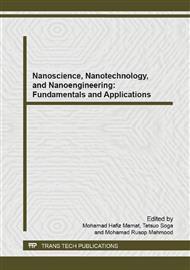[13]
Fig. 1: (a) AFM and (b) FESEM images of silicon diode with 35 nm gap width The lateral diodes are varied only in gap width; the emitter geometries are controlled and are kept constant during the electrical measurement. The radius curvature of the apex is set to 60 nm. The two devices with different gap widths of 35 and 55 nm were separately considered for FE under similar vacuum environments of lower than 10–9 Torr [10, 14]. The I–V characteristic was determined for each device and the results were compared. The lateral emitter was designed to have a high geometrical aspect ratio with a small curvature radius of the emitter tip. The emission current of the various emitters is related to the modified F–N equation.
Google Scholar
[15]
Log (I/V2) = log (a) + 0. 434 (- b/V) (1) where , φ is work function in eV, A is emitting area in cm2and β is the field enhancement factor (in cm–1), which depends on electrode shape. Fig. 2: (a) I-V curves of the field emission for different distance d (b)Corresponding F-N plots The effect of varying the gap width is reflected in the I–V characteristics, with a clear reduction in the turn-on voltage as the anode–cathode gap decreases (Fig. 2). The Si lateral diode with 55 nm and 35 nm gap width exhibits turn-on voltages of 21 and 16 V, respectively. The I–V characteristics of the devices are graphically presented in Fig. 2a. The anode current of approximately 6 µA was obtained at 32 to 33 V for the 35 and 50 nm gap widths, respectively. These results show that the emission current rapidly increases after the turn-on voltage is applied. The emission current from the lateral emitters is consistent with the F–N behavior, as shown in Fig. 2b. When the gap width between the emitter and the anode electrode decreases, the electric field increases . The high electric field decreases the potential barrier at the surface; thus, the electrons can tunnel from inside the semiconductor to the vacuum [5, 16]. For narrowed nano-gaps from 55 to 35 nm, therefore, the turn-on voltage decreases from 21 to 16 V. The value of β was determined from the F–N plot slope. The β and A values for a gap width of 55 nm are 0. 58 × 107 cm–1 and 3. 35 × 10–18 cm2, respectively (Fig. 2b). Our results indicate that β decreases and the emitting area increases with increasing gap width. Conclution Round-tip emitters with nanoscale gaps of 35 to 55 nm were fabricated by advanced nanofabrication technology based on AFM nanolithography and wet etching. I-V characteristics show that the gap width of electrodes is effective parameters in lateral silicon field emission diodes. For the narrowed nano-gaps from 55 nm to 35 nm, the turn-on voltage decreased from 21 V to 16 V. Refrences.
Google Scholar
[1]
J. Rouhi, M.R. Mahmood, S. Mahmud, R. Dalvand, The effect of emitter geometry on lateral field emission diodes fabricated by AFM-based electrochemical nanolithography, Journal of Solid State Electrochemistry, 18 (2014) 1695-1700.
DOI: 10.1007/s10008-014-2403-5
Google Scholar
[2]
W. Milne, K. Teo, M. Mann, I. Bu, G. Amaratunga, N. De Jonge, M. Allioux, J. Oostveen, P. Legagneux, E. Minoux, Carbon nanotubes as electron sources, physica status solidi (a), 203 (2006) 1058-1063.
DOI: 10.1002/pssa.200566101
Google Scholar
[3]
J. Rouhi, S.D. Hutagalung, S. Kakooei, S. Mahmud, Fabrication of nanogap electrodes via nano-oxidation mask by scanning probe microscopy nanolithography, Journal of Micro/Nanolithography, MEMS, and MOEMS, 10 (2011) 043002-043002-043003.
DOI: 10.1117/1.3643480
Google Scholar
[4]
J. Rouhi, S. Mahmud, S. Hutagalung, N. Naderi, Field emission in lateral silicon diode fabricated by atomic force microscopy lithography, Electronics letters, 48 (2012) 712-714.
DOI: 10.1049/el.2012.1020
Google Scholar
[5]
K. Eswar, J. Rouhi, H. Husairi, M. Rusop, S. Abdullah, Annealing heat treatment of ZnO nanoparticles grown on porous Si substrate using spin-coating method, Advances in Materials Science and Engineering, 2014 (2014) 6.
DOI: 10.1155/2014/796759
Google Scholar
[6]
J. Rouhi, M. Alimanesh, S. Mahmud, R. Dalvand, C. Raymond Ooi, M. Rusop, A novel method for synthesis of well-aligned hexagonal cone-shaped ZnO nanostructures in field emission applications, Materials Letters, 125 (2014) 147-150.
DOI: 10.1016/j.matlet.2014.03.183
Google Scholar
[7]
N. Naderi, M. Hashim, J. Rouhi, H. Mahmodi, Enhanced optical and electrical stability of thermally carbonized porous silicon, Materials Science in Semiconductor Processing, 16 (2013) 542-546.
DOI: 10.1016/j.mssp.2012.09.010
Google Scholar
[8]
J. Rouhi, S. Mahmud, N. Naderi, C.R. Ooi, M.R. Mahmood, Physical properties of fish gelatin-based bio-nanocomposite films incorporated with ZnO nanorods, Nanoscale research letters, 8 (2013) 1-6.
DOI: 10.1186/1556-276x-8-364
Google Scholar
[9]
T. Li, W. Hu, D. Zhu, Nanogap electrodes, Advanced Materials, 22 (2010) 286-300.
Google Scholar
[10]
K. Eswar, J. Rouhi, F. Husairi, R. Dalvand, S.A. Alrokayan, H.A. Khan, M. Rusop Mahmood, S. Abdullah, Hydrothermal growth of flower-like ZnO nanostructures on porous silicon substrate, Journal of Molecular Structure, (2014).
DOI: 10.1016/j.molstruc.2014.05.067
Google Scholar
[11]
Z.J. Davis, G. Abadal, O. Hansen, X. Borise, N. Barniol, F. Perez-Murano, A. Boisen, AFM lithography of aluminum for fabrication of nanomechanical systems, Ultramicroscopy, 97 (2003) 467-472.
DOI: 10.1016/s0304-3991(03)00075-5
Google Scholar
[12]
H. Sugimura, N. Nakagiri, AFM lithography in constant current mode, Nanotechnology, 8 (1997) A15.
DOI: 10.1088/0957-4484/8/3a/004
Google Scholar
[13]
J. Rouhi, S. Mahmud, S.D. Hutagalung, N. Naderi, S. Kakooei, M.J. Abdullah, Controlling the shape and gap width of silicon electrodes using local anodic oxidation and anisotropic TMAH wet etching, Semiconductor Science and Technology, 27 (2012).
DOI: 10.1088/0268-1242/27/6/065001
Google Scholar
[14]
J. Rouhi, M. Alimanesh, S. Mahmud, R.A. Dalvand, C.H.R. Ooi, M. Rusop, Optical properties of well-aligned ZnO nanostructure arrays synthesized by an electric field-assisted aqueous solution method, Ceramics International, 40 (2014) 11193–11198.
DOI: 10.1016/j.ceramint.2014.03.157
Google Scholar
[15]
R. Fowler, L. Nordheim, Containing papers of a mathematical and physical character. R. Soc, in: Proc. A, 1928, pp.173-181.
Google Scholar
[16]
J. Rouhi, S. Mahmud, S.D. Hutagalung, S. Kakooei, Optimisation of nanooxide mask fabricated by atomic force microscopy nanolithography: a response surface methodology application, Micro & Nano Letters, IET, 7 (2012) 325-328.
DOI: 10.1049/mnl.2011.0658
Google Scholar


